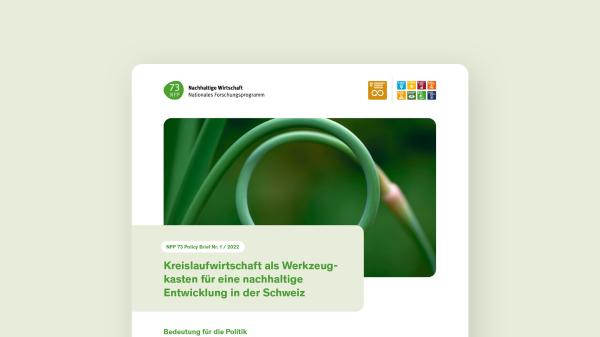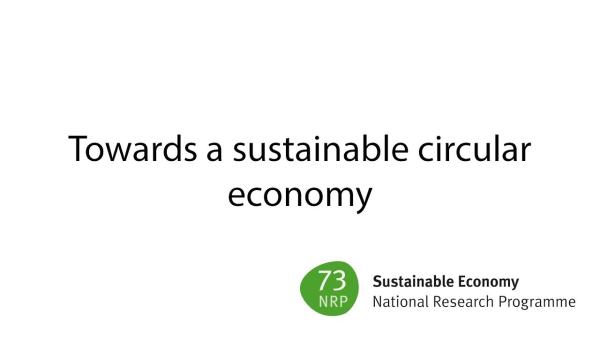Towards a sustainable circular economy
The project ‘Towards A sustainable CircuLar Economy’ (TACLE) combined a material flow with a business and policy perspective. Its main goal was to determine the hidden potentials for improving resource management in Switzerland, and to pave the way towards a sustainable circular economy (SCE).

Background
With increased population growth and changing consumption patterns, the stress on natural resources has increased globally. The concept of a Circular Economy (CE) has gained popularity in the context of policy, business and research as a means to address this issue. Yet, there are significant knowledge gaps related to the implementation and implications of a circular economy, and we sought to address these gaps in this project.
Aims
he goals of the project were to (i) identify and quantify opportunities for improving resource efficiency in Swiss industry through a sustainable circular economy (SCE); (ii) analyse how companies build/reconfigure value chains towards a sustainable circular economy and (iii) support policymaking and industry in transition to an SCE. The overarching research question of the project was the following: What are the hidden potentials for improving resource management in Switzerland, and how can they be used to implement a sustainable circular economy?
Results
We identified and quantified opportunities for improving resource efficiency in the Swiss economy through a sustainable circular economy from both resource and socioeconomic perspectives. New indicators for measuring the environmental and economic sustainability of the circular economy were developed. Case studies of thermal insulation, furniture, textile clothing and plastics were environmentally assessed and, with the exception of textiles, also analysed from a socioeconomic perspective.
We found that in the thermal insulation industry, the implementation of circular strategies such as reducing and recycling have the highest implementation potential from both a cost and a resource perspective. In the case of furniture, a number of internal and external factors such as the modularity of the furniture’s design or transportation distances for re-use/re-manufacture are crucial for a successful CE transition of furniture companies. Refurbishing of furniture, including a take-back scheme, and repairing of clothing showed the highest environmental impact mitigation potential. We further saw that rebound effects (i.e. spending saved money on other goods or services) can offset the benefits from reduced consumption or prolonged use of clothing or furniture. The analysis of the plastic packaging industry showed the importance for policymakers to understand the entire spectrum of regulatory solutions to circular economy barriers, and how different value players are affected, in order to foster a sustainable circular economy.
The analysis related to building/reconfiguring value chains towards a sustainable circular economy demonstrated the relevance of disruptive circular innovations by firms - such as design for disassembly in the construction sector or enzymatic recycling for plastics and textiles - and organisational aspects (interdependencies between stakeholders, collective reconceptualisation of the established value chain) in fostering a transition towards a sustainable circular economy.
Overall, it is key for policymaking to carefully consider economic, environmental and social aspects in the transition towards a circular economy, in addition to the conceptual criterion of material circularity, where material circularity is a measure for the amount of material in circulation.
Implication for research
The project generated important theoretical and methodological contributions. We developed an environmental assessment framework for the evaluation of circular economy strategies as well as environmental and economic CE indicators and contributed to the discussion around sustainability aspects of the CE. In addition, our insights on barriers inhibiting the transition to a CE and our analysis of different value chains contributed to a better understanding of the role of organisations and the importance of policy in this transition.
Implication for practice
The developed environmental and economic assessment frameworks, as well as findings from the case study, provide a scientific basis for i) policymakers by pointing out environmental and economic hotspots in selected value chains and barriers to a circular economy and ii) industry by presenting and evaluating options for closing material loops and their environmental and economic implementation potential. The developed environmental indicator – retained environmental value (REV) - was integrated into the target system of Swiss Recycling and, as a consequence of a postulate within the Swiss Parliament, its nationwide application. It is currently being evaluated by the Federal Office for the Environment (FOEN).
Publications
Project partners
Prof. Dr. Volker Hoffmann
Group for Sustainability & Technology
ETH Zürich
Prof. Dr. Stefanie Hellweg
Group for Ecological Systems Design
ETH Zürich
Projektpartner
Climate-KIC
EMPA
Isofloc
ISOVER St. Gobain
Pavatex
Swisspor
Thermo Natur


